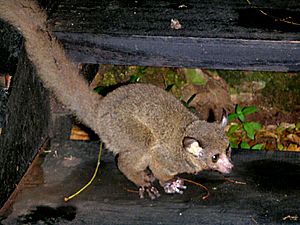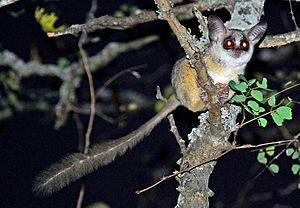Galago facts for kids
Quick facts for kids Galagos |
|
|---|---|
 |
|
| Brown greater galago (Otolemur crassicaudatus) | |
| Scientific classification | |
| Kingdom: | |
| Phylum: | |
| Class: | |
| Order: | |
| Suborder: | |
| Infraorder: | |
| Superfamily: | |
| Family: |
Galagidae
Gray, 1825
|
| Genera | |
|
Otolemur |
|
Galagos, also known as bushbabies, are small primates that live in Africa. People also call them nagapies, which means "little night monkeys" in Afrikaans. There are 21 different types, or species, of galagos. They all belong to the animal family called Galagidae.
Galagos are nocturnal, meaning they are active at night and sleep during the day. They are known for their big eyes, amazing jumping skills, and loud calls.
Contents
Where Do Galagos Live?
Galagos live in most of the forests and shrub areas of Africa, south of the Sahara Desert. You can also find them on some nearby islands, like Zanzibar. However, they do not live on Madagascar.
These animals are very successful. They are the most common type of prosimian (a group of primates) found in Africa.
What Do Galagos Look Like?
Galagos have several special features that help them survive. They have very large eyes, which give them excellent night vision. Their strong back legs help them jump far, and their long tails help them keep their balance.
Their ears look a bit like a bat's ears. They can move them to help find insects in the dark. Galagos are quick and agile. When they jump through thick bushes, they fold their delicate ears back to protect them. They also fold their ears when they are resting.
Most of their toes have nails, except for the second toe on their back foot. This toe has a special grooming claw that they use to clean themselves.
What Do Galagos Eat?
Galagos are omnivorous, which means they eat both plants and animals. However, they mostly eat insects. Their favorite food is grasshoppers. They also enjoy small birds, eggs, fruits, seeds, and flowers.
One type of galago, called Euoticus, has special front teeth. These teeth help it remove tree bark so it can eat the sticky tree gum underneath.
How Do Galagos Communicate?
Galagos talk to each other using different calls. They also mark their paths with urine. By following the smell of their urine, they can land on the exact same branch every time.
All galago species make unique 'loud calls'. These calls help them identify each other from far away. Scientists can even tell different galago species apart just by listening to their calls! When the night ends, galagos gather together. They use a special rallying call to find each other before sleeping in a nest made of leaves, a group of branches, or a hole in a tree.
Amazing Jumping Skills
Galagos are incredible jumpers. Some can jump as high as 2.25 meters (about 7.4 feet)! This is amazing, especially for an animal their size. Scientists believe their leg muscles and special tendons help them store energy, allowing them to jump much farther than you might expect.
When they are jumping through the air, they pull their arms and legs close to their body. Then, at the very last second, they stretch them out to grab a branch. A galago can cover ten yards in just a few seconds by making a series of quick jumps. Their tail is longer than their head and body combined. It helps their powerful leg muscles push them during jumps.
Galagos can also hop like a kangaroo or simply run on all four legs. Their strong, coordinated movements are controlled by a special part of their brain.
Galago Life Cycle and Family Life
After being pregnant for about 110 to 133 days, baby galagos are born. Their eyes are only partly open, and they cannot move around by themselves at first. After about 6 to 8 days, the mother carries her baby in her mouth. She places it on branches while she looks for food.
Female galagos can have one, two, or even three babies at a time. Each newborn weighs less than half an ounce. For the first three days, the baby stays very close to its mother. The mother feeds her young for six weeks, and they can start feeding themselves at two months old. The babies grow quickly, which can make it hard for the mother to carry them around.
Female galagos have their own areas, called territories. They share these areas with their young. Male galagos leave their mother's territory when they become adults. However, female galagos usually stay, forming social groups with their close relatives and their babies.
Adult males have their own separate territories. These territories often overlap with the areas where female groups live. Usually, one adult male will mate with all the females in his area. Sometimes, males who don't have their own territories form small groups together.
Social Behavior
Galagos have a mix of social and solitary behaviors. You can see this in how they play. They might swing from branches or climb high and throw things. Social play includes play fights, play grooming, and following-play. In following-play, two galagos jump around and chase each other through the trees.
Older galagos in a group often prefer to rest alone. Younger ones, however, like to stay in constant contact with each other. Mothers sometimes leave their babies alone for long periods and don't try to stop them from wandering off. On the other hand, the babies try to stay close to their mother and start interactions with her.
Grooming is a very important part of a galago's daily life. They often groom themselves before, during, and after resting. Social grooming, where they groom each other, is done more often by males in the group. Females sometimes do not accept grooming attempts from males.
Can Galagos Be Pets?
Keeping galagos as pets is generally not a good idea. Like many wild animals, they can carry diseases that can spread to humans. Also, bringing them into many countries can cause problems with customs officials. In zoos, galagos can live for 12 to 16 years, which suggests they can live for over a decade in the wild.
Images for kids
See also
 In Spanish: Gálagos para niños
In Spanish: Gálagos para niños





